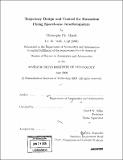Trajectory design and control for formation flying spaceborne interferometers
Author(s)
Mandy, Christophe Ph. (Christophe Philippe)
DownloadFull printable version (45.86Mb)
Other Contributors
Massachusetts Institute of Technology. Dept. of Aeronautics and Astronautics.
Advisor
David W. Miller.
Terms of use
Metadata
Show full item recordAbstract
Spaceborne interferometry promises to greatly expand our knowledge of astronomy and astrophysics, and open the doors to many new discoveries. The purpose of this study is to investigate optimal resource management techniques for separated space-craft interferometers to successfully synthesize images. Assuming optimal imaging configurations that satisfy astronomical requirements have been selected, a two-step approach is taken to satisfy these requirements: (1) develop a framework to man-age control effort among different satellites during observation and retargeting of the spacecraft formations, to thereby maximize the number of observations that can be taken with a given amount of consumables, and (2) determine computationally efficient control techniques to minimize control effort while meeting image synthesis metrics. First, issues relating to planning optimal trajectories that trade imaging metrics for spacecraft design metrics such as mission length and spacecraft mass are addressed. The determination of optimal spacecraft locations or trajectories for image acquisition is studied to satisfy astronomical constraints. These positioning requirements lead to the computation of trajectories for the retargeting of formation flying interferometers to capture images of a new astronomical target. Second, the trajectories planned under this approach are used in the formulation of a tracking control problem for spaceborne interferometric apertures. (cont.) The assumptions made in the control problem are used as a basis for the development of different control techniques that trade image quality for fuel expenditure, and evaluated according to scenarios involving different properties relevant to synthetic imaging. The result from these two steps are then applied to the SPHERES testbed, a six-degree-of-freedom facility designed for the incremental maturation of formation flight technologies in a risk-tolerant microgravity environment. Results from simulations and experiments on board the space station are presented and compared to their theoretical outcomes.
Description
Thesis (S.M.)--Massachusetts Institute of Technology, Dept. of Aeronautics and Astronautics, 2009. Includes bibliographical references (p. 125-127).
Date issued
2009Department
Massachusetts Institute of Technology. Department of Aeronautics and AstronauticsPublisher
Massachusetts Institute of Technology
Keywords
Aeronautics and Astronautics.